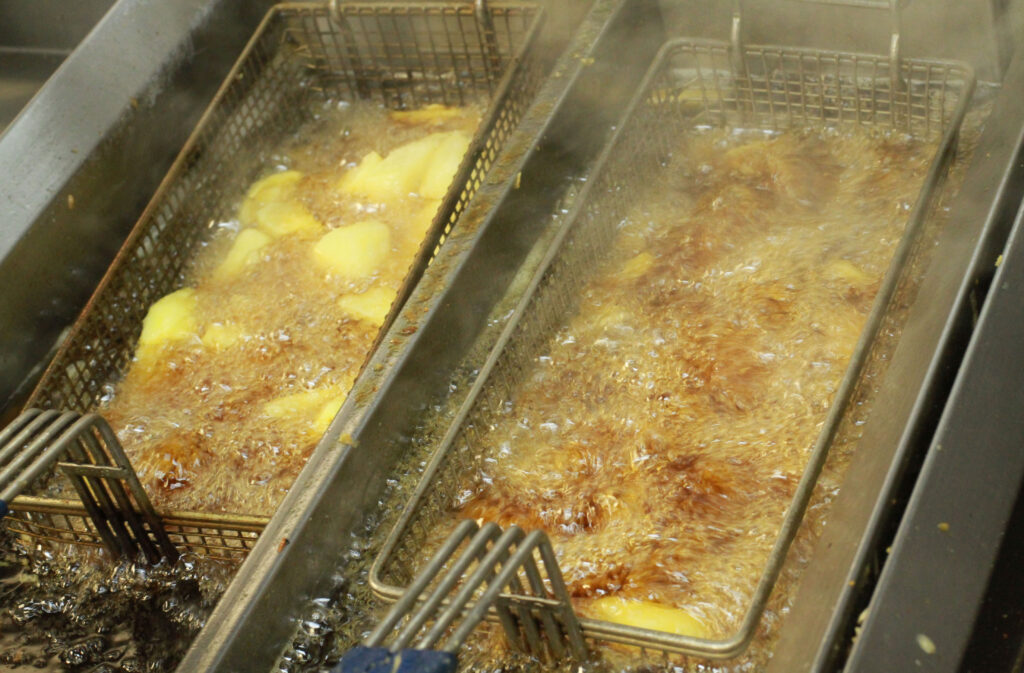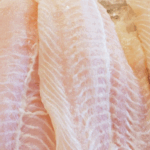What influences your choice of frying medium, and would you ever consider switching? We speak to leading friers from successful chip shops across the UK to uncover their preferences and the reasons behind them
Selecting the right frying medium is crucial for the success of any fish and chip shop. It not only impacts the flavour of the food but also influences customer satisfaction and business profitability. The decision regarding which frying medium to use should not be taken lightly or underestimated.
For some shops, the choice is clear-cut, based on tradition and regional preferences. For example, Our Plaice in Hagley, Worcestershire, owned by Gregg Howard, has been using beef dripping since Gregg’s father opened the business in 1968. This choice was influenced by the local frying practices of the time. When Gregg took over in the early 1980s, he continued this tradition, maintaining the established flavour and culinary heritage of the shop. He comments: “Beef dripping gives that traditional taste of fish and chips, it’s how people remember fish and chips.”
Once a staunch beef dripping area, Gregg has resisted the temptation to switch to vegetable oil, like many other shops around him have, to cater to vegetarians and vegans. He adds: “It’s pretty much us now in our area that cooks in beef dripping so it’s our USP and people travel to us because it sets us aside from everybody else. We hear it all the time from customers as they are walking out, “that’s the best fish and chips I’ve had in years”. They probably don’t realise why, but we know it’s because we fry in beef dripping and that’s how people remember the fish and chips years ago.”
As well as the superior taste Gregg believes beef dripping has, he also favours it from a health perspective. Made from rendered fat, it is non-hydrogenated and low in trans fats, which Gregg believes is better than some other frying mediums which undergo much more processing: “I liken it to a real ale: there are no chemicals in it because it is a by-product so it’s natural, it’s got nothing added to it.”
Follower of tradition
Zero Plus Fish Bar in Cardiff is another follower of tradition and, once again, it is taste and customer preference that has seen palm oil filling up the fryers for over 30 years. Even under the ownership of second-generation frier Zohaib Hussain for the past few years, the choice of frying medium has remained the same.
“Traditionally south Wales is a palm oil area, so our customers do expect that,” says Zohaib. “However, the main reason I use palm is because it lets the flavour of the food come out. I’ve tasted fish and chips cooked in rapeseed, beef dripping and peanut oil but I feel it mixes with the flavour of the food. We’d rather a frying medium that is tasteless and has the pure flavour of the food come out.”
For Zohaib, traceability and sustainability are also important factors in any product he buys for his business, which is built on eco-friendly practices. Zohaib adds: “We are getting more customers ask what we fry in but it’s more the origin that they’re worried about, not what we use. So we’re able to tell them we use sustainable palm and that the yield of palm far outweighs the yield of rapeseed and other oils on the market so it’s the right solution.”


Over in London, where fish and chip chain Poppies operates four of the capital’s busiest takeaways and restaurants, founder Ural Hassan chooses to fry in groundnut oil.
“We’ve always fried in groundnut oil,” says Ural. “When we looked into the health side of it, it was healthier than using rapeseed oils and vegetable oils in terms of cholesterol. Also, it has a higher burning point than vegetable oils. Cooking in burnt oil is the worst, because of the flavour it imparts to the food.”
Costing a premium, Ural and his team undertake weekly oil consumption monitoring and testing to ensure the quality is always high. His kitchen porters take test tubes of oil from the pans and if it hits a certain colour, it is changed.
“We are really on this oil thing so we know how much money we should be taking to the oil consumption and we check that on a weekly basis,” says Ural. “If we start seeing our oil consumption go really high and the takings are the same, we know that there’s something wrong with that oil and we’ll get it tested because it can affect our margins. Everything is so tight now, with utilities and the cost of ingredients so we’re on those numbers all the time for quality of product and our bottom line.”
Personal preferences
While most operators will use only one frying medium, it’s not uncommon these days to find shops offering a vegetable oil pan and a beef dripping pan. What is quite unique, however, is how Chez Fred in Bournemouth operates. It uses high oleic sunflower oil for fish and rapeseed for chips.
The decision to use vegetable oil is driven by regional tastes, however, the choice to use two different types is a mix of financial considerations and owner Fred Capel’s personal preference.
“They both fry quite similarly,” says Fred. “They’re both good on chips, but I don’t like rapeseed on fish. Rapeseed is probably a fiver a barrel less than sunflower and because we’ve got two separate dump tanks for our chip pans and our fish pans, it’s very easy to keep our oils separate – not that there would be a problem if they were to mix. But in all honesty, if the price of rapeseed hit a similar price to sunflower, I would just move to sunflower. It’s really just a cost saving, which you might as well make when you can do great chips in rapeseed.”
Fred also likes the ease of use of a liquid oil over a solid fat, but admits it does require more skill to get a good product. “There’s no doubt that beef dripping fries better fish and chips in my view because it’s easier to get your fish crispy in a solid oil than in a liquid oil. What this means is that we have to work hard on our batter to get it as crispy as you would with a solid oil.”
Many operators will refuse point-blank to switch their frying medium, while others have taken the bold step. John Molnar, owner of the five-strong chain The Cod’s Scallops, moved his shops to vegetable oil after nine years of frying in beef dripping in a bid to attract vegetarians and vegans.
“Ultimately I did it because, during lockdown, we provided about 5,000 meals over six months to less fortunate families – not fish and chips but pasta and rice meals – and what I found was 25% were vegetarian. I thought there were customers there that I was missing out on.”
For four weeks, the business didn’t have one negative comment, however, when it went public with the news, there was a huge backlash, showcasing how strong customer feelings can be on this issue. “One customer wrote a four-page email to me and said it was the biggest disaster to hit Nottingham after Covid,” says John.
Despite some negativity, turnover remained steady, encouraging John to stick with his decision. However, he has since added a beef dripping pan back into his flagship shop in Bramcote Lane in Nottingham on the basis that he has two nearby shops that fry in vegetable oil, therefore, providing customers with more options and catering to diverse preferences.
As well as opening up new markets, the switch to vegetable oil has had unexpected benefits. John adds: “Clean downs are probably an hour less because it is easier to move oil around than beef dripping which solidifies overnight. And we’re using less energy as we don’t have to put all the pans on to melt to pan across some oil.”
Having had experience with both frying mediums, John can relate to Fred Capel’s thought process of using two frying mediums, adding: “Personally, I think the chips are better fried in beef dripping but sometimes it masks the flavour of the fish. If I had a perfect scenario, I’d have a fryer built that would just do chips in dripping and fish in vegetable oil.”

Wide audience
Catering to as wide an audience as possible dictated the frying medium Tiffany and Ross Irvin used when they opened The Fish Works in Largs, North Ayrshire, seven years ago. Although many of the businesses around them were using beef dripping, they chose to hit the ground running with palm oil, with Tiffany adding: “Because we were new to the industry we looked at all the available frying mediums and felt palm oil was the best option if we wanted to cater for vegans and vegetarians.”
Easier to embed this change in a beef dripping area as they were newcomers and hadn’t used anything else, it gave them a USP when setting up and has had the desired effect of attracting a wide customer base – in particular Halal customers.
“It’s not a market we have targeted with advertising, it must just have spread via word of mouth because we’ve had a huge increase in the number of Halal customers over the last couple of years,” says Tiffany. “Sometimes we’ll get a bus trip stop with 30-40 Halal customers and they feel confident when they come in because our head frier, who is Halal, shows them that we don’t cook any beef products, it’s only chicken and fish, and we’re getting more and more daily.”
In contrast to The Fish Works being newcomers, Raffo’s in Belfast has used beef dripping since Darren Raffo opened the takeaway 26 years ago. A fourth-generation frier, beef dripping is what his great-great-grandfather used when he first started in fish and chips and there was no other choice available. Buying a premium brand, Darren says it’s the taste and the quality that he is interested in.
“I only buy the best and I think customers appreciate it because the same customers have been coming back every week for 25 years and they are bringing their children, so it’s generational now.
“I’ve tried several different brands, but they don’t come close to the product we use. There’s no aftertaste and there is no odour either – some fats can give off a strong smell but ours doesn’t.”
When choosing a frying medium, it’s important to balance a range of factors such as flavour, health considerations, local preferences, cost, and dietary restrictions to best serve your customers.
There’s no one-size-fits-all answer. Ultimately, it’s about what works best for your business and meets your customers’ needs. However, two factors should always be prioritised: invest in the best quality you can afford and maintain your products in optimal condition.
The five main frying mediums
Beef Dripping: Traditional and renowned for its rich, savoury flavour. Consists mainly of saturated and monounsaturated fats, making it suitable for cooking at high temperatures. Unsuitable for vegetarian and vegan customers.
Rapeseed Oil: Valued for its light taste and high smoke point, rapeseed oil is also a healthier option with lower saturated fat content.
Sunflower Oil: Offers a light flavour and a high smoke point, making it ideal for frying at high temperatures.
Groundnut Oil: Known for its slightly nutty flavour and high smoke point, but it may put some customers off due to allergen concerns.
Palm Oil: Frequently used for its high smoke point and stability. Consists mostly of saturated and monounsaturated fats, making it a great choice for deep frying.
Recent Posts
- Marine scientists recommend quota cut for cod but increase for haddock in 2026
- Government sets timeline for Employment Rights Bill measures to come into effect
- National Fish & Chip Awards 2026 open with new category for menu innovation
- Frymax announces Fry to the Max prize draw winners
- National Fish & Chip Day campaign evaluation is in – and it looks impressive!








